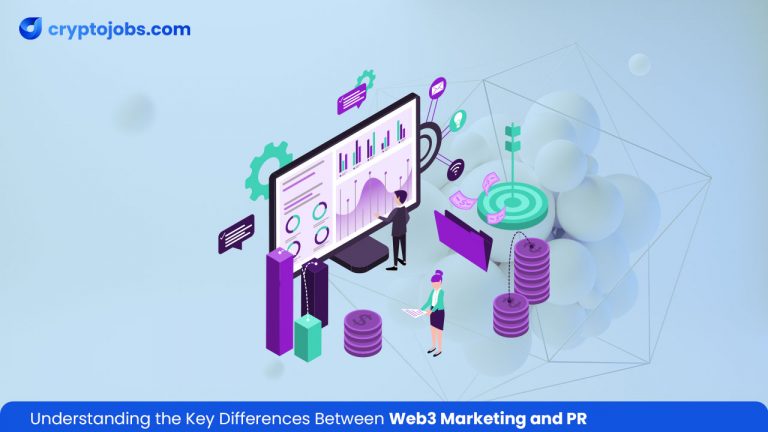
Understanding the Key Differences Between Web3 Marketing and PR
- cryptojobs.com
- July 5, 2024
- All Posts, Web3
- Web3
- 0 Comments
The emergence of Web3 has created a transformative shift in how businesses approach marketing and public relations (PR). As blockchain innovation and decentralized technologies gain momentum, they bring with them a host of new opportunities and challenges for brands seeking to connect with their audience.
Web3 PR and marketing play a vital role in this effort. However, start-ups and companies are not sure if they need to hire a PR team or a marketing team. Although things can get pretty confusing between these two professions, it is still notably evident and must be taken into account when companies are thinking about hiring a suitable person for the team.
The main reason behind this confusion is that the objectives, issues, and sometimes even strategies are somewhat similar for marketing and PR. Here is the basic difference between PR and marketing to form a foundation – while marketing focuses on simply releasing and selling a product via promotion events, ideas, or services, PR helps form a positive image of the product.
Let’s examine each of the roles, their differences, and the objectives behind them in this article.
Are you a talented professional looking to find your dream PR or marketing job in the Web3 industry? Look no further; register with cryptojobs.com today to find the most sought-after opportunities.
What is PR?
Public Relations, or PR, is the practice of maintaining a product’s or service’s positive image among the masses or potential consumers. The positive image helps boost sales and revenues as a greater number of people form opinions that the product is useful and effective.
The department involved in PR management usually builds a good understanding and a mutually beneficial relationship with the partnering or collaborating company, person, or brand. PR’s main channel is typically social media; however, it may extend into other platforms as well.
Here are a few of the main PR purposes:
- Media relations
- Reputation management
- Promotion
- Increase sales and revenue
- Successful event planning
- Brand journalism
- Developing awareness regarding the product or service
The PR department may also be among the first responders to negative press. Since their main purpose is to form a positive image, the PR department may help damage control by covering the unfavorable circumstances. They may mitigate through putting a positive spin on the situation or issuing a formal apology on behalf of the company.
A similar job that you might be interested in is PR Associate. You can apply here: https://www.cryptojobs.com/job/pr-associate-cis-cee-region-2340
What is Marketing?
The other important term is marketing. It is the process of introducing a product or service into the market for the audience to try instead of offering them a positive review in the first place.
Marketing includes putting a product or service out there, adding to its viewers and potential customers, and devising plans to deliver the true value of the product or service. Marketing strategies usually consist of the following:
- Content marketing
- Billboard or poster marketing
- Email marketing
- Commercial marketing
- Social media marketing
- Influencer marketing
Using these various forms, the audience becomes familiar with the product or service. Marketing’s main purpose is to convince the audience to consume, buy, or at least engage with the product so they can also share their opinion regarding it.
Over time, as consumers use the product or service, they begin to form a relationship with it, possibly prompting close family or friends to use it as well. This results in a long-term customer and increased profits for the company.
A similar job that you might be interested in is Marketing Manager. You can apply here: https://www.cryptojobs.com/job/marketing-manager-2221
Check out: 7 Career Options for Marketing Graduates
Key Differences Between Web3 Marketing and Web3 PR
Here are the key differences between Web3 PR and marketing:
Main Objectives
Though it may seem similar, PR and marketing departments have quite different responsibilities. You will often find PR professionals preparing releases, putting out professional, positive stories about a product or service, and maintaining beneficial media relationships.
On the other hand, marketing professionals focus on thoroughly planning product launches, creating innovative marketing campaigns, and conducting extensive client research.
Audience & Consumers
Another notable difference between marketing and PR is that they have different consumers and audiences, though they may overlap. The PR department mostly interacts with audiences as per the company’s needs at the time.
For instance, a PR team may have to contact the media, employees, or company stakeholders to create a positive outlook. At other times, the PR team may be involved in handling a negative event or press, minimizing damage through various channels.
In contrast, the marketing department mainly works on reaching the general public, targeting specific groups most relevant to the product or service. They simply want the audience to try the product, and share reviews later on.
Goals
The PR and marketing teams have very different short-term and long-term goals, and they achieve them through different methods. In contrast, PR is mostly focused on creating a beneficial image for the company in order to connect with the audience emotionally. The audience may involve stakeholders, employees, influencers, etc.
In contrast, the marketing department works toward increasing customer reach and other prospect, thereby increasing company sales.
Metrics of Success
Another key distinction to consider between PR and marketing is how they measure success. Both departments have different performance indicators that they rely on. The PR professionals assess whether they have created a positive or negative effect.
In case of a disadvantageous situation, the PR team comes up with effective strategies to turn the odds in their favor. In contrast, marketing professionals evaluate if the released product or service has gained ample attention, as planned initially. They take note of the Return on Investment (ROI) and make any required modifications. Furthermore, they also assist in planning promotional events or campaigns.
What is PR in Marketing?
While both professions are different, PR and marketing do overlap in some situations. PR is primarily a form of strategic communication. It is an extension of marketing that focuses on shaping and managing an organization’s reputation and image in the public eye.
There are some inevitable overlaps between the two, as the success of one partly relies on the other. Similarly, if one is under pressure or bad press, the other has to help control damage.
Social media is one tool that both PR and marketing use to convey their respective messages and achieve their goals. This is mainly because social media is an excellent outlet for building brand awareness as well as carrying out target market campaigns. Occasionally, they may even occur entirely together – PR in Marketing.
Check out: A Step-by-Step Guide to Starting a Career as a Web3 PR Manager
PR in marketing helps develop a good rapport among customers, partners or stakeholders, and the general public. It is not advertising but a calculated method of developing and maintaining a good, advantageous perception of a brand, company, or individual. PR involves multiple channels, such as community engagement, media coverage, and other communicative means.
PR in Marketing – Key Aspects
Here are the commonest key aspects of PR in marketing:
- Media Relations
- Content Creation
- Active Communication
- Crisis Management
- Event Management
- Problem-solving
- Social Media Engagement
- Community and Employee Engagement
- Influencer Marketing
- Awards and Publicity
- Excellent Organization
Final Thoughts
While there are several differences between marketing and PR, the key point is that the former involves boosting awareness and sales through promotion, whereas the latter is all about building a positive brand image.
Finding Web3 jobs in the competitive web3 space can be stress-free with cryptojobs.com, as top Web3 and crypto companies trust the platform for hiring the best talent. Start your job search today and find a position that matches your skillset.




